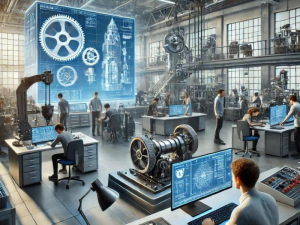Mechanical Engineer: Complete Guide to Fundamentals and Theory
Introduction
A mechanical engineer is a professional who designs, analyzes, and builds machines and systems that make everyday life easier. From engines and automobiles to robots and power plants, mechanical engineers apply the principles of physics, mathematics, and material science to develop efficient, reliable, and innovative mechanical systems. They play a vital role in industries such as energy, manufacturing, automotive, aerospace, robotics, and construction.
The foundation of mechanical engineering lies in understanding forces, motion, heat, and materials—allowing engineers to create systems that convert energy into useful work.
Mechanical engineering is one of the broadest fields in engineering. It combines creativity with problem-solving, making it an ideal choice for those interested in how things work and how they can be improved. The responsibilities of a mechanical engineer include product design, testing, manufacturing process development, and maintenance of mechanical systems. Whether it’s designing a high-performance engine or developing renewable energy technologies, a mechanical engineer’s work shapes the modern world.

Main Branches of Mechanical Engineering
Mechanical engineering includes several key sub-disciplines. These branches include:
- Thermodynamics – Focuses on energy conversion and heat transfer.
- Fluid Mechanics – Studies the behavior of liquids and gases.
- Materials Science – Examines how different materials respond to stress, heat, and deformation.
- Design Engineering – Involves creating mechanical components and systems using CAD tools.
- Manufacturing Engineering – Deals with production processes like machining, welding, and casting.
Each branch works together to solve real-world engineering problems efficiently and safely.
Statics and Dynamics
In mechanical engineering, statics deals with forces in systems that are at rest, while dynamics focuses on objects in motion. Statics helps engineers ensure structures remain stable, while dynamics is essential for analyzing motion in engines, vehicles, and machinery.
Stress, Strain, and Material Behavior
Stress is the internal force per unit area within a material, while strain measures the amount of deformation under that force. Understanding stress and strain helps mechanical engineers design components that are strong yet flexible enough to avoid failure. The stress-strain curve reveals how a material behaves under load, showing its elastic (reversible) and plastic (permanent) deformation limits.
Another key term, Young’s modulus, measures stiffness and helps predict how materials will stretch under force.
Thermodynamics: The Laws That Govern Energy
The first law of thermodynamics states that energy cannot be created or destroyed—only transformed. Mechanical engineers use this principle to design systems like engines, refrigerators, and turbines that efficiently convert energy into work.
The second law of thermodynamics explains that energy naturally flows from higher to lower temperatures. This law guides engineers in designing energy-efficient systems and understanding concepts like entropy and heat transfer.
Heat Transfer Methods
Heat transfer occurs in three ways: conduction, convection, and radiation.
- Conduction happens when heat moves through solid materials.
- Convection occurs in fluids like air or water when heated particles move.
- Radiation transfers heat through electromagnetic waves, like sunlight warming the Earth.
Mechanical engineers apply these principles to design engines, heating systems, and cooling equipment
Fluid Mechanics and Reynolds Number
The Reynolds number helps determine whether a fluid’s flow is laminar (smooth) or turbulent (chaotic). Low Reynolds numbers indicate smooth flow, while high numbers indicate turbulence. Understanding this is vital in pipe design, aerodynamics, and pump systems, ensuring efficient and safe operation.
Basic Mechanical Elements: Bearings, Gears, and Shafts
A bearing supports and reduces friction between moving parts, while gears transmit power through rotational motion. Shafts carry torque from one component to another. These elements form the backbone of mechanical design, allowing machines to run smoothly and efficiently.
Factor of Safety and Design Reliability
The factor of safety (FOS) ensures that designs can handle unexpected loads or stresses beyond calculated values. It’s a crucial concept for mechanical engineers to prevent structural failures and enhance safety in real-world conditions.
Fatigue, Buckling, and Failure Modes
Fatigue occurs when a material weakens under repeated stress cycles, while buckling happens when compression causes a structure to collapse. Mechanical engineers must analyze these failure modes to design durable components and structures capable of withstanding long-term use.
Thermal Expansion and Its Impact
Materials expand when heated and contract when cooled—a process called thermal expansion. Mechanical engineers must consider this in design, especially in bridges, engines, and pipelines, to prevent damage due to temperature changes.
CAD and CAM: The Digital Tools of Engineers
Modern mechanical engineers rely heavily on CAD (Computer-Aided Design) and CAM (Computer-Aided Manufacturing). CAD software such as AutoCAD and SolidWorks allows engineers to create precise 3D models, while CAM software helps in manufacturing these parts accurately using CNC machines. These tools reduce design time, enhance accuracy, and support product innovation.
Welding, Soldering, and Brazing
Mechanical engineers use different joining methods based on strength, temperature, and materials.
- Welding joins metals by melting them together, suitable for heavy-duty applications.
- Soldering and brazing use filler materials at lower temperatures, ideal for delicate or dissimilar metals.
Each technique ensures strong and durable connections in mechanical structures. 
Modes of Mechanical Failure
Common failure modes include fracture, fatigue, wear, and corrosion. Understanding these helps mechanical engineers design components that last longer and perform better under stress and environmental exposure.
Conclusion
Mechanical engineering forms the foundation of technological advancement in the modern world. A mechanical engineer blends science, creativity, and innovation to solve real-world problems—whether designing efficient engines, developing renewable energy systems, or optimizing manufacturing processes. With a deep understanding of mechanics, thermodynamics, materials, and design principles, mechanical engineers continue to shape the future through sustainable and intelligent engineering solutions.
And if you are interested in this job then click here https://jobonlineapply.com/

